The Great Stones Shimmer on Hatunrumiyoq Street

Massive, irregular stones incline inward while making a jungle of light and shadow on three sides of what is today called the Palacio del Arzobispo. One of the great tourist attractions of Cuzco, these walls contain the famous “Stone of Twelve Angles” by which almost every tourist has had their picture taken and which are reputed to have formed the palace of Inca Roca, one of the Empire’s rulers. But Adam Herring, a prominent professor of Art History at Southern Methodist University recently challenged that notion.
In the prominent academic journal Critical Inquiry Herring noted that the three walls are far more than simply a wall for holding up a building, they are sculpture.
The famous twelve angled stone, like the other stones of the wall was carved many times to make corrections as the stones of the wall were pieced together like an irregular landscape. They create an almost liquid feel where one loses sense of the mass and weight of the wall as the play of light on the irregular surface changes its color and produces new shapes as the day wears on.
In this play of light and the constant movement of light on the wall, producing a kind of shimmering effect, Herring finds the answer to one of his questions. “How did this masonry encode Inca ways of seeing, building, and imagining?” The moving shimmer is key.
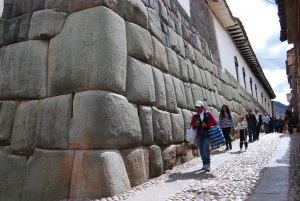
From almost any vantage, the building’s footing is seen to pull down and away from the walls, thus accentuating the upright stance of the structure and the sculptural volume. The building carries over a gentle crest on Calle Hatunrumiyoc as if riding a swell. The effect ripples through the structure, heaving the masonry mass off plumb. Individual blocks shift and jostle, while the broader wall surfaces along the building well out or pull back. The polyangular stones are of no standard size, as if subject only to overriding structural impulses of expansion and compression. Pit scars and protruding nubbins from individual building blocks punctuate the blocks’ grainy surfaces. These irregular textures disrupt the sunlight that falls across the wall; surface eccentricities break the sunlight apart, denying the viewer any easy perceptual bearing. […]
Better, the masonry constitutes an in-built questioning of weight and load, surface and volume, subject-viewer and thing unto itself. Sharp seers in the twentieth century have remarked on “the pathways of meandering curiosity” that configure this architecture, as well as the masonry’s broader tendency to “pulsate.”30 “In the Wall of Silk . . . the stone of twelve facets scintillates,” wrote surrealist poet César Moro in 1943.31 All these observations register the wall’s capacity to suspend the architectonic norms of gravity and structure and to substitute the logic of the embodied gaze in their place.

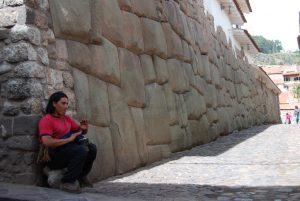
From this, Herring goes on to argue that the wall confirms that vision and sight is central to the logic and ways knowledge was created and empire maintained among the Incas. The shimmering relates to the understanding of the great God Ticsi Viracocha who was arguably the creator, as well as to the first Inca Manco Capac, and thence to the Inca Emperors as people who, like the sun, sat on top of a hierarchy of vision, movement, and glow that organized and entire empire.
As a result, Herring argues that the three walls were not a palace or a building. He says the attribution to Inca Roca is very faulty and stems from a misunderstanding of the Spanish and of history. He sees the meaning as being Inca stone (s) instead of a palace of a probably mythical ruler.
Instead, Herring claims the walls retained dirt, making a free standing platform on which there was probably some sort of temple The missing wall, the fourth wall, would have held a divided staircase rising up onto the shimmering and changing platform.
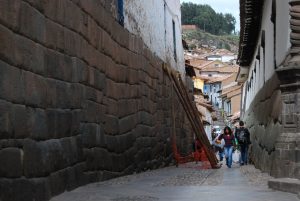
From the top of that platform, Herring holds, the Inca could see the summit of Huanacauri, the important peak where one of the original Inca Ayar brothers and sisters turned into stone and which was always important in rites of passage within the Inca nobility.
Furthermore, the name of the first Incas, Manco Capac suggests, according to Herring, the notion of a cave or of coming from the earth as the Incas did. As a result, this platform would have been of great religious and political significance.
Today the massive walls mark the passage from the old Inca city between the two rivers, the Saphi and the Tullumayu. In front of the contemporary palace the Tuyllumayu passes, chanelled under the street.
Where today the neighborhood of San Blas rises, with its picturesque white adobe walls and orange tile roofs, stood rows of terraces, sacred gardens that climbed up the hillside towards the precincts of Sacsayhuaman. One can still see pieces of these terraces in the area known as Jardines del Inca.
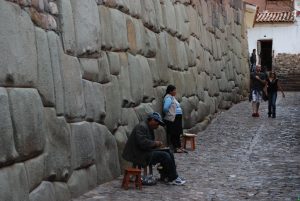
Through these terraces and by the massive walls of the platform passed the road to jungle, the Qapaq Ñan.
From the entrance to that road, in front of the platform, it would have stood like a flat-topped mountain before a rising network of terraces as a symbol of the energy held by the Inca to channel life and power into nature, the production of crops and the production of life, according to Herring.
Whether platform or palace, the unusual walls are certainly worth spending time watching as the day passes. They truly are one of the great monuments of the Inca and something of which one never tires. Herring’s article makes an important contribution towards understanding them and their place in the ideas that made Tawantinsuyo, the Inca Empire work.
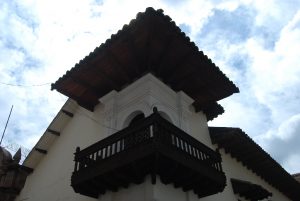
Reference:
Adam Herring, “Shimmering Foundation: The Twelve-Angled Stone of Inca Cusco”. Critical Inquiry, 37:1:60-105, 2010.




